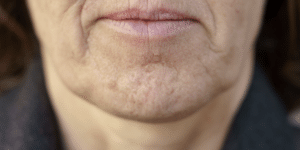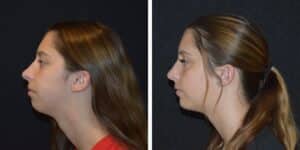Dimpled Chin: Causes and Treatment Options
A dimpled chin, sometimes called a “pebble chin” or “orange peel chin,” is a common cosmetic concern where the skin on the chin appears uneven, bumpy, or wrinkled. Many people notice that their chin takes on this appearance as they age or due to underlying muscle activity.
But what exactly causes a dimpled chin, and how can it be treated? In this post, we’ll break down the anatomy of the chin, the role muscles play in creating dimpling, and both short-term and long-term solutions to smooth it out.
Anatomy of the Chin: Muscles and Skin
The chin is primarily controlled by a muscle called the mentalis. This muscle attaches to the skin of the chin and helps with facial expressions, especially those involving the lower face, like closing the mouth or puckering the lips. The constant tone in this muscle can pull the skin tightly, creating the appearance of dimpling or wrinkling.
The muscle fibers of the mentalis are directly connected to the skin, which means that when the muscle is active, it can pull the skin inward, leading to a bumpy or uneven appearance. Over time, or with excessive muscle activity, these indentations can become more permanent.
The Link Between a Recessed Chin and Dimpling
A recessed chin, where the chin appears to be set back from the rest of the face, can also contribute to a dimpled chin. When the chin is recessed, the muscles of the chin—especially the mentalis—have to work harder to keep the mouth closed, since there is less bone support. This constant effort can increase the tone in the muscles, making dimpling more pronounced.
Several factors can lead to a recessed chin, including:
- Overbite: When the upper teeth significantly overlap the lower teeth, the lower jaw may recede, leading to a less prominent chin.
- Retrogenia: This condition is characterized by an underdeveloped lower jaw, which can cause a weak or receding chin. This can be a genetic trait or develop over time due to changes in bone structure or dental issues.

Short-Term Fix: Neuromodulators for Dimpled Chin
One of the first treatment options many people turn to for a dimpled chin is neuromodulators like Botox or Dysport. Neuromodulators work by temporarily weakening the mentalis muscle, reducing its ability to pull on the skin and cause dimpling.
While neuromodulators can smooth out the appearance of a dimpled chin, they don’t address the underlying issue—whether it’s muscle tone or a recessed chin. This means the treatment needs to be repeated every few months to maintain results.
Long-Term Fix: Chin Augmentation
For those seeking a more permanent solution, chin augmentation may be necessary. By enhancing the projection of the chin, augmentation can provide better support to the overlying muscles and prevent the constant tension that leads to dimpling.
There are several options for chin augmentation:
Dermal Fillers (Radiesse or Juvederm): Dermal fillers can add temporary volume to the chin. Radiesse, in particular, is often used because it is thicker and provides more structural support. Fillers are injected to improve the contour and projection of the chin, which can reduce muscle strain. While this is a non-surgical option, it typically lasts between 12-18 months, after which more filler may be needed.
Chin Implants: A chin implant is a more permanent solution. It involves placing a silicone or other biocompatible material implant over the bone of the chin to increase its projection. This provides more structural support to the overlying muscles, reducing the need for them to stay constantly engaged. Over time, the muscles will relax, and the appearance of dimpling will be reduced.
Sliding Genioplasty: For more significant chin recession, a sliding genioplasty may be required. This is a surgical procedure where the chin bone is cut and moved forward. Unlike an implant, which only adds volume, sliding genioplasty changes the position of the chin bone itself, providing more natural results for some patients. This surgery also permanently addresses the underlying cause of a recessed chin.

Combining Neuromodulators with Chin Augmentation
In some cases, after chin augmentation, whether with an implant or sliding genioplasty, neuromodulators may still be needed for a short period. The reason is that the mentalis muscle has been used to working overtime to support a recessed chin. It may take time for the muscle to relax fully after the structural issue is corrected. However, after several months, many patients find they no longer need neuromodulators because the muscle has adjusted to the new shape and projection of the chin.
Ablative Skin Resurfacing to Treat Chin Dimpling and Wrinkles
Over time, a recessed chin combined with constant muscle contraction can lead to deep wrinkles and dimpling in the overlying skin. These lines form as the mentalis muscle exerts repetitive tension, eventually creating textural changes that can become permanent. Ablative resurfacing with a CO2 or Erbium:Yag laser effectively reduces these lines by precisely removing the damaged outer layers of skin while promoting collagen production in the deeper layers.
The Erbium:Yag laser, such as the Sciton Contour TRL used in our office, allows for precise control of the treatment depth with minimal heat spread to surrounding tissues. This precision helps smooth the skin and reduce deep lines while supporting natural healing and collagen remodeling, making it a highly effective option for addressing this specific concern.
The Role of Fat in Chin Appearance
The soft tissues of the chin also play a role in the appearance of a dimpled chin. Specifically, fat in the chin acts as a cushion between the muscle fibers and the skin. When there is an adequate amount of fat in the chin, it can help smooth the appearance of the skin, reducing dimpling.
However, certain treatments, such as radiofrequency (RF) energy devices that target fat for reduction, can actually worsen a dimpled chin if done too deeply. If RF treatments go below the dermis and affect the fat in the chin, it can lead to fat loss in this area. Without this cushion of fat, the muscle fibers can pull on the skin more directly, making the dimpled appearance more pronounced.
Final Thoughts
A dimpled chin can be caused by a combination of muscle activity and underlying bone structure, particularly in those with a recessed chin. While neuromodulators can offer a temporary fix by relaxing the mentalis muscle, addressing the root cause through chin augmentation provides a more permanent solution.
If you’re struggling with a dimpled chin and are unsure of the best treatment option, contact us for a consultation with Dr. Saxon can help determine the most appropriate solution for your individual case.
You May Also Like